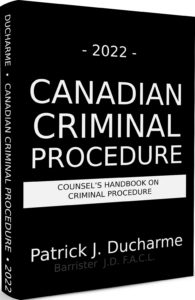 |
| Patrick Ducharme |
This defence is rarely used in Canada. It only arises in circumstances where an accused is alleged to have committed a crime, and, he does not deny the actions that support the inference of a crime. Instead, he claims that he has a lawful excuse for his actions.
The prosecutor, when the defence of necessity is raised, has an obligation to prove, beyond a reasonable doubt, that the acts of the accused in relation to the offence, were committed voluntarily and were the result of his free choice to break the law.
The accused, in contrast, needs to present evidence in support of his “necessity” to break the law. In order to do so, the defence of necessity needs clear and cogent evidence of some form of danger or emergency such that normal human instincts required the accused to breach the law in order to preserve himself or others that he perceived to be in danger.
Our law does allow for this narrow defence in genuine cases of emergency. The law of Canada supports the proposition that it is unfair to require strict adherence to our laws in circumstances of extreme danger. The defence of necessity is rarely advanced, probably because it is a rare circumstance that one is faced with an urgent, dangerous situation, that requires possible or actual damage or harm to others in order to avoid the imminent danger or peril.
Nevertheless, necessity is a valid excuse to avoid conviction for a crime, preserved by subsection 8 (3) of the Code. This subsection provides that every rule and principle of the common law that renders any circumstance a justification or excuse for an act or a defence to a charge continues in force and applies in respect of proceedings for an offence under this Act or any other Act of Parliament except in so far as they are altered by or are inconsistent with this Act or any other Act of Parliament.
The Supreme Court of Canada in 1984 in a unanimous decision decided that there are three elements to the defence of necessity. They are:
1. imminent peril or danger.
2. the absence of a reasonable legal alternative.
3. proportionality between the harm inflicted and the harm avoided. With respect to this last element of the defence, this requirement must be assessed on an objective standard.
This defence of necessity does not excuse the infliction of a greater harm than the harm attempted to be avoided by the accused. But, where the accused places before the court enough evidence to raise the issue, the onus is upon the prosecution to meet that challenge by the accused on a regular standard of proof beyond a reasonable doubt.

The above is the an excerpt of Patrick J Ducharme's book, Canadian Criminal Procedure, available at Amazon or in bulk through MedicaLegal Publishing along with Criminal Trial Strategies.
Subscribe to Patrick Ducharme's Youtube Channel
